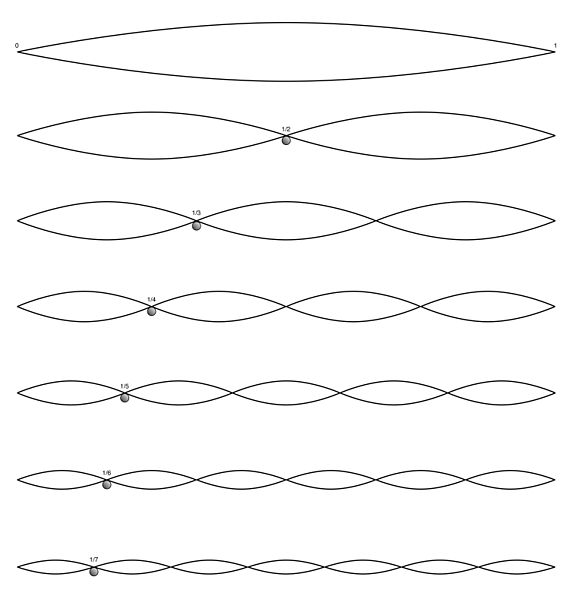Consonance/Dissonance/(Just) Intonation/Harmony
Dividing string lengths
When you divide a string in ½, 1/3, ¼ , 1/5 etc of its total length, interesting phenomena occur. The resulting tones or frequencies have a specific relation with the basic frequency: octave, octave and fifth, double octave, double octave and major third, etcetera. String players are familiar with this phenomenon in the use they make of flageolet tones.
Let us assume we are going to divide in this way a string with a basic frequency of C2. As a result we obtain the following tones (see note example).

A striking fact is, that the distance between consecutive tones decreases. Also the first six tones of the series form the harmony of a major triad. The markings above the tones 7, 11 and 13 indicate that they deviate (strongly) from the frequencies we use in our daily practice for those tones.
Harmonic series
The frequencies of the stringlengths 1, ½, 1/3, ¼ etc. Relate to each other as 1:2:3:4 etc. A pure octave above a (440Hz) has a frequency of 880 Hz. The series we get in this way is known as the harmonic series or as harmonics or overtones. The phenomenon of overtones by the way was discovered much later than the described way of dividing strings.
Just Intonation and Beats
Intervals or even chords that resemble the proportions of this series we experience as “pure” consonant, because there are no beats to be heard. When tuning an instrument (as soon as you try to match an a at 440 Hz) you immediately have to do with beats. A soon as the “vibrating” disappears and the sound becomes stable, you know you are in tune. This can clearly be experienced when listening to the tuning of open strings of a violin for example, although in practice string players adapt some fifths between open strings. Nowadays we mostly use the so called equal temperament. With this way of tuning the octave (on a correctly tuned piano) is the only interval that is perfectly in tune, in terms of the proportions of the harmonic series. We will go into the complexities of tuning and temperament at another place and time.
Overtones
Overtones or harmonics are tones that are so to speak “enclosed” in the sound of an instrument and which resonate along with the basic frequency of a tone. The way in which this happens determines for a great deal the timbre or colour of an instrument. This phenomenon can be easily demonstrated on a piano, by (without using the right pedal!) pressing down the tones 4, 5 and 6 of the discussed series and striking the lowest C of the series. You will hear the triad resonating. The strings resonate with the enclosed frequencies of the low c. When you try the same thing with another triad like d-f#-a the effect does not appear. The more harmonics of together sounding tones, intervals, chords are “in conflict”, the more we experience the beats in the sound. This phenomenon als occurs in downward direction; play for example on a violin a g' on the d-string and you will see that the open g-string starts to vibrate.
Consonance and Dissonance
In the term consonance there are two words present: con (with) and sonare (to sound). Or in other words: sounding with …, being in harmony. The word resonate literally means sounding together with another sound(source). Dissonance is of course the opposite of consonance. The terms consonance and dissonance have an acoustic (physical) and a psychological aspect: what we experience as being beautiful, or acceptable, ugly, or strange depends on our experience, accommodation and (cultural) agreements. A very important expressive aspect of music is the way in which dissonants are continued, for example by “resolving” them. This is used as a way of building up tension and creating relaxation. Another example is the use of the concluding chord in a composition. In the middle ages an octave or an octave with pure fifth, in the later renaissance and afterward a (major) triad, in jazz a triad with added note (added sixth for example).
Harmony
Since the baroque our western music is “triad-based”. We speak about this music in general as tonal music. The way in which we connect chords is part of the study of harmony.



